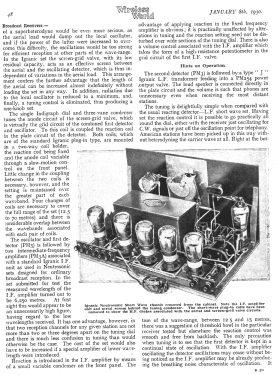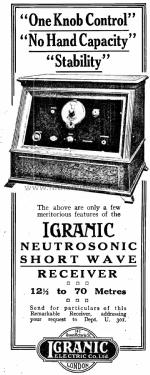Neutrosonic Short Wave
Igranic Electric Co. Ltd.; Bedford
- País
- Gran Bretaña (GB)
- Fabricante / Marca
- Igranic Electric Co. Ltd.; Bedford
- Año
- 1929
- Categoría
- Radio - o Sintonizador pasado WW2
- Radiomuseum.org ID
- 182876
Haga clic en la miniatura esquemática para solicitarlo como documento gratuito.
- Numero de valvulas
- 6
- Principio principal
- Superheterodino con realimentación; ZF/IF 48 kHz; Screengrid 1926-1935
- Gama de ondas
- Onda Corta solamente
- Tensión de funcionamiento
- Baterías recargables o pilas
- Altavoz
- - Este modelo usa altavoz exterior (1 o más).
- Material
- Madera
- de Radiomuseum.org
- Modelo: Neutrosonic Short Wave - Igranic Electric Co. Ltd.;
- Forma
- Sobremesa de frontis inclinado.
- Anotaciones
-
The Superheterodyne Principle to Shortwave Reception was described in Wireless World in January 1930.
The article discusses a new radio receiver from Igranic that uses the superheterodyne principle to receive shortwave signals effectively.
Key points:
- The superheterodyne principle is used to convert the incoming frequency to a lower value for easier amplification, particularly for frequencies below 100 metres.
- Igranic's set demonstrates good control over these high frequencies, functioning down to 15 metres.
- The set uses an aperiodic aerial circuit, avoiding the problems of harmonics and blind spots encountered with tuned circuits.
- A screen-grid valve acts as a buffer between the aerial and oscillator, improving stability and allowing for longer aerials.
- The set features a single tuning dial and a slow-motion control for reaction, simplifying operation.
- Four sets of coils cover the entire range (12.5 to 70 metres) with overlapping bands for finer tuning.
- The intermediate-frequency amplifier operates at a higher wavelength (6,250 metres) for easier tuning and to avoid confusion with other stations.
- Reaction is introduced in the I.F. amplifier, providing stable control and minimizing adjustments.
- The set delivers strong audio output, eliminating the need for headphones.
- Overall, the Igranic radio receiver appears to be a well-designed and effective solution for shortwave reception, offering advantages in stability, ease of use, and performance.
The price in oak, including valves, coils and royalties, but excluding batteries and loudspeaker, is £28.
- Precio durante el primer año
- 28.00 GBP
- Documentación / Esquemas (1)
- Wireless World (The), London (WW, 79) (JAN 8, 1930)
- Autor
- Modelo creado por Roy Johnson. Ver en "Modificar Ficha" los participantes posteriores.
- Otros modelos
-
Donde encontrará 37 modelos, 35 con imágenes y 2 con esquemas.
Ir al listado general de Igranic Electric Co. Ltd.; Bedford






